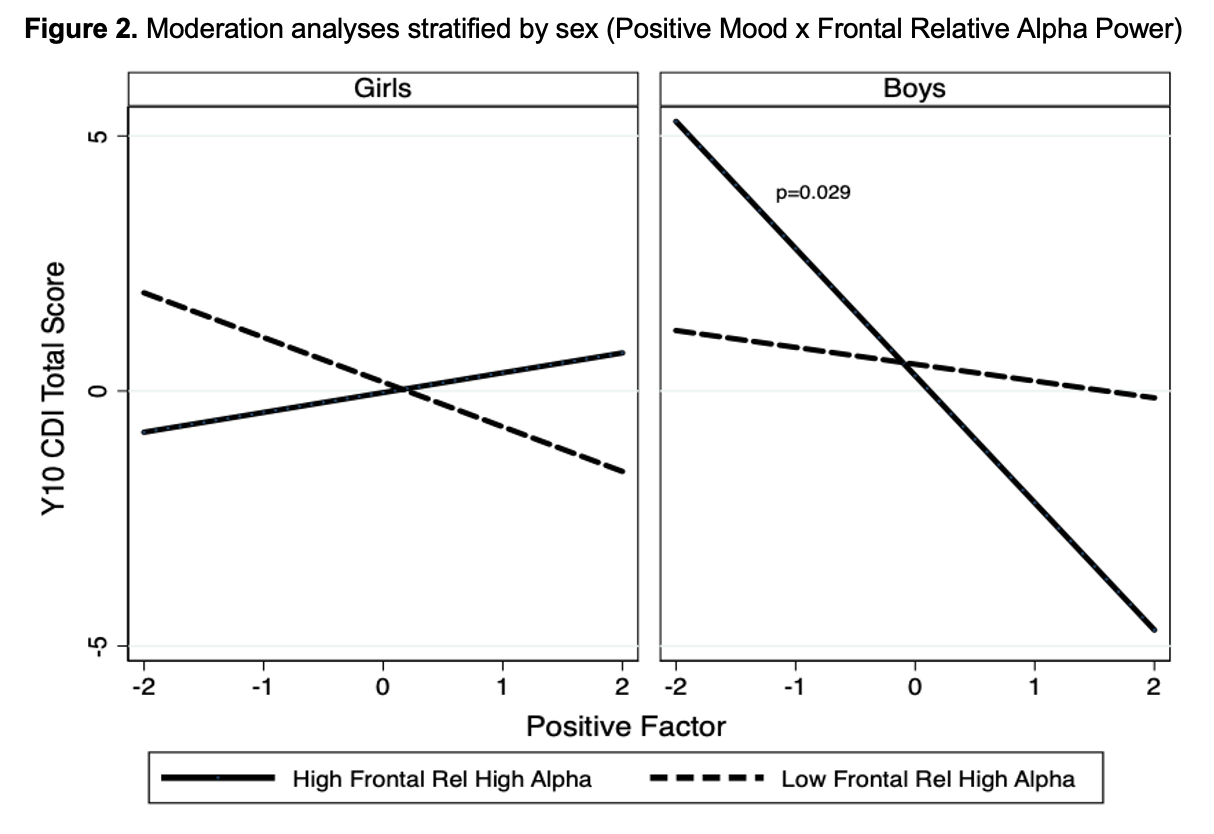Back
Background: Existing research has predominantly focused on examining the adverse effects of antenatal maternal mood on child development outcomes. Antenatal positive mood has recently been shown to benefit socioemotional development of offspring, serving as a protective factor against familial depression risk.
Objective: We aim to understand sex differences in the association between antenatal positive mood and the offspring’s depression risk by examining individual differences in EEG patterns during infancy.
Design/Methods: In this longitudinal birth cohort, mothers completed depression and anxiety measures at 26-28 weeks’ gestation and 3 months after birth, for which a bi-factor analyses generated antenatal maternal positive and negative mood factors. Children underwent EEG at 18 months (n=150) and self-reported depressive symptoms using the Child Depression Inventory (CDI) at age 10 (n=473). Linear regression examined the relationship between antenatal maternal positive mood, its interaction with sex, and CDI at age 10. Correlation analysis was used to understand infant EEG power that associated with both prenatal positive maternal mood and CDI at age 10. Lastly, moderation analyses were conducted to understand whether any identified neural correlates moderated the relationship between antenatal maternal positive mood and later child depressive symptoms at age 10 when stratified by sex.
Results: Linear regression showed a negative association between antenatal positive mood and child depressive symptoms at 10 years. (B = -0.72, 95% CI [-1.38, -0.064], p=0.031). Positive relationships were observed between antenatal positive maternal mood and child EEG power of alpha and beta relative frequencies at 18 months. Higher infant EEG relative alpha power in the left frontal region was found to be associated with CDI at 10 years in boys (r=0.31, p=0.018; see Figure 1). No significant correlations were found in girls. A stronger negative relationship between antenatal maternal positive mood and child depressive symptoms at 10 years was observed only in boys with higher levels of relative alpha power (B = -0.10, 95% CI [-0.19, -0.012], p=0.025; see Figure 2).
Conclusion(s): While most studies have focused on the association between negative maternal mood and brain maturational lag measured using EEG, our study is the first to report the positive association between antenatal positive mood and brain maturation in young children. We found that a sex-specific EEG correlate related to brain maturation interacted with antenatal positive maternal mood and later child depressive symptoms.
Figure 1
.png)
Figure 2.

Mental Health 2
Session: Mental Health 2
766 - Antenatal positive maternal mood and child depressive symptoms: Moderation by EEG alpha power
Saturday, April 26, 2025
2:30pm – 4:45pm HST
Shuping Lim, National University of Singapore, Singapore, N/A, Singapore; Evelyn Law, National University of Singapore, Singapore, N/A, Singapore

Evelyn C. Law, MD (she/her/hers)
Assistant Professor and Principal Investigator
National University of Singapore, Institute for Human Development and Potential
The Colony, Texas, United States
Presenting Author(s)
Background: Existing research has predominantly focused on examining the adverse effects of antenatal maternal mood on child development outcomes. Antenatal positive mood has recently been shown to benefit socioemotional development of offspring, serving as a protective factor against familial depression risk.
Objective: We aim to understand sex differences in the association between antenatal positive mood and the offspring’s depression risk by examining individual differences in EEG patterns during infancy.
Design/Methods: In this longitudinal birth cohort, mothers completed depression and anxiety measures at 26-28 weeks’ gestation and 3 months after birth, for which a bi-factor analyses generated antenatal maternal positive and negative mood factors. Children underwent EEG at 18 months (n=150) and self-reported depressive symptoms using the Child Depression Inventory (CDI) at age 10 (n=473). Linear regression examined the relationship between antenatal maternal positive mood, its interaction with sex, and CDI at age 10. Correlation analysis was used to understand infant EEG power that associated with both prenatal positive maternal mood and CDI at age 10. Lastly, moderation analyses were conducted to understand whether any identified neural correlates moderated the relationship between antenatal maternal positive mood and later child depressive symptoms at age 10 when stratified by sex.
Results: Linear regression showed a negative association between antenatal positive mood and child depressive symptoms at 10 years. (B = -0.72, 95% CI [-1.38, -0.064], p=0.031). Positive relationships were observed between antenatal positive maternal mood and child EEG power of alpha and beta relative frequencies at 18 months. Higher infant EEG relative alpha power in the left frontal region was found to be associated with CDI at 10 years in boys (r=0.31, p=0.018; see Figure 1). No significant correlations were found in girls. A stronger negative relationship between antenatal maternal positive mood and child depressive symptoms at 10 years was observed only in boys with higher levels of relative alpha power (B = -0.10, 95% CI [-0.19, -0.012], p=0.025; see Figure 2).
Conclusion(s): While most studies have focused on the association between negative maternal mood and brain maturational lag measured using EEG, our study is the first to report the positive association between antenatal positive mood and brain maturation in young children. We found that a sex-specific EEG correlate related to brain maturation interacted with antenatal positive maternal mood and later child depressive symptoms.
Figure 1
.png)
Figure 2.


